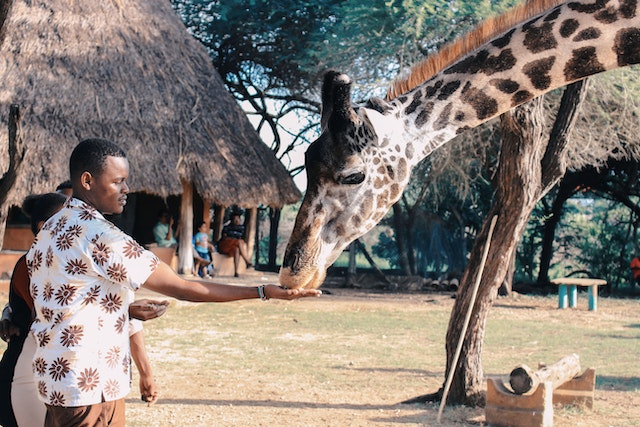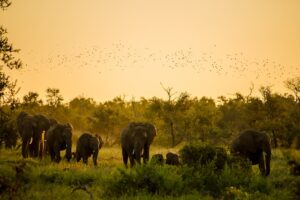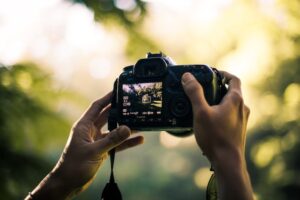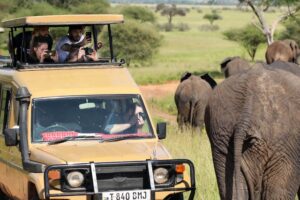
The Wildlife Photography Tips for Your Kenyan Safari
Posted on June 15, 2023
Kenya’s lush landscapes and abundant wildlife present a remarkable tableau for photographers worldwide. If you’re interested in wildlife photography, this African nation offers an unmatched setting. Its vast savannahs, diverse habitats, and a plethora of animal species provide a canvas unlike any other. This guide aims to equip you with essential wildlife photography tips for your Kenyan Safari. It’s more than just clicking the shutter at the right moment; it’s about understanding the animals, reading the environment, and employing patience. Kenya’s unique ecosystems serve as an open-air studio where you can hone your skills and develop an appreciation for nature.

Kenya has a rich biodiversity with many species of wild animals, which every photographer will love
Understanding photography tips for Kenyan Safari: A Photographer’s Dream
Kenya, as a popular safari destination, is home to an incredible variety of wildlife species, making it a photographer’s dream. The country’s rich biodiversity encompasses mighty African elephants, majestic lions, elusive leopards, graceful giraffes, and vibrant flamingos, among many others. Each creature adds a unique element to your photography, enabling you to capture diverse and thrilling aspects of life in the wild. Moreover, Kenya’s diverse landscapes, from the sprawling savannahs to the breathtaking lakes and mountains, provide an array of backdrops for your shots. This variety enhances the aesthetic appeal of your images but also adds depth and context to your wildlife stories. Therefore, before you set out to explore Kenya’s Wildlife National Parks, it’s crucial to familiarize yourself with the safari and plan your wildlife photography accordingly. This understanding helps you to anticipate, adapt, and seize every photographic opportunity that comes your way.
Wildlife Photography Tips for Your Kenyan Safari: An In-Depth Guide
When it comes to wildlife photography tips, there are a few key factors to consider in order to capture those breathtaking shots you dream of:
- Understand your subject: Take time to observe and understand the animal. Each has unique behaviors and habits that can affect your photography.
- Keep a safe distance: Some large animals, like lions or elephants, may require you to keep a safe distance, so having a zoom lens can prove invaluable.
- Use natural light: In wildlife photography, natural light is your best friend. Understand its direction and intensity to create stunning images.
- Composition is essential: play with different compositions to bring out the best in your images. The rule of thirds is a great starting point.
- Be patient: Be prepared to wait hours for that perfect shot.
- Respect wildlife: Do not provoke or disturb animals for photography.

Remember to bring the equipment you’ll need to make beautiful photographs.
Right Equipment for the Safari
Bringing the right equipment is just as necessary as having photography skills. It is what separates a stunning wildlife portrait or an entirely missed shot. Here are some essential pieces of equipment to consider in the list of photography tips for your Kenyan safari:
- Camera: A reliable DSLR or mirrorless camera is a must. Ensure it has the right autofocus system and can handle high ISOs for low light conditions.
- Lenses: A telephoto lens is crucial for wildlife photography. It allows you to photograph animals from a distance without disturbing them.
- Tripod: A sturdy, lightweight tripod is invaluable for steady and sharp images.
- Protection: Kenya’s environment can be harsh. So, it’s wise to keep your gear protected, so consider packing a camera bag for travel with protective covers for dust, moisture, and unexpected weather conditions.
- Extra Batteries and Memory Cards: The last thing you want is to run out of power or storage when the perfect shot presents itself. Always carry spares.
Mastering the Art of Patience is key among photography tips for your Kenyan safari.
One of the most vital yet often overlooked aspects of wildlife photography is patience. Wildlife is unpredictable. Animals won’t pose or appear on demand. When you book a safari in Kenya, you must remember that you are entering the world of wild animals where they live at their own pace and that you cannot predict every moment and every situation. There will be times when you have to wait for hours to get the perfect shot or when you return with no usable photos. But, when patience finally pays off, and you get that one stunning shot, the satisfaction is immense. As a wildlife photographer, I’ve spent countless hours waiting for the right moment, and those experiences have taught me that patience isn’t just a virtue; it’s a necessity in this field.

One of the most important wildlife photography tips for your Kenyan safari is to always prioritize safety and keep your distance from the animals.
Prioritize safety.
Prioritizing safety is one of the most paramount wildlife photography tips for your Kenyan safari. It will ensure your well-being but also respects the wildlife and habitats. Always:
- Follow Guides and Park Rules: Always adhere to the instructions given by your guide and park rules. They protect your and wildlife’s safety.
- Maintain a Safe Distance: Never approach animals too closely. Use your zoom lens to capture close-up shots.
- Avoid Night-Time Photography: Avoid venturing out after dark unless guided by a professional. Wild animals are unpredictable, and it’s safer to restrict photography to daylight hours.
- Pack Smartly: As professionals from Triple7movers.com advise, pack light but ensure you have all essentials, including first-aid kits, sunscreens, and insect repellants.
- Stay Hydrated and Protected: The African sun can be harsh, so ensure you’re well-protected and hydrated.
Remember, a successful photography safari is one where you return with beautiful photos and unforgettable memories without jeopardizing your safety or that of the wildlife.
Understanding the Best Time for and Photography tips for your Kenyan Safari co-twinned.
The timing of your Kenyan safari can considerably influence the quality of your wildlife photographs. Among photographers, early mornings and late afternoons are often called the ‘golden hours’ because they are the best times for photography. The soft, warm light during these hours adds a beautiful glow to your images, bringing out the textures and details of the wildlife and landscape. Furthermore, many animals are most active during these times, increasing your chances of capturing compelling action shots.
In terms of seasons, the best time to visit Kenya for wildlife photography is during the dry months, from January to March and July to October. It is when animals congregate around water sources, making them easier to spot and photograph. However, each season offers unique photographic opportunities, so choose based on what you’re most interested in capturing. For example, while considering photography tips for your Kenyan safari listed above bear in mind that these are not all but the most crucial ones. This may vary depending on one’s interests and general geography of the whole safari itinerary.
Conclusion
Understanding your subjects, packing the right equipment, mastering patience, choosing the correct timing, and prioritizing safety are key wildlife photography tips for your Kenyan Safari. Embrace these tips and get ready to explore the splendid wildlife photography opportunities that Kenya has to offer. Your adventure awaits!
However, know that you the best Photography Tips for Your Kenyan Safari, do you know the best Kenya safari holiday tour packages available? Here, you cannot miss one safaris tours in Kenya
Other photography tips for your Kenyan safari to consider is the choice of vehicle, the experience of the driver guide and location of the accommodation. For instance, if interested in migration of wildebeest at Masai mara, considering the timing between July-September is essential like location of lodge. Some lodges and camps might be located miles away from migration areas.
What are where are the best photography destinations in Kenya?
Inasmuch as Kenya is diverse and has a lot to offer to any photographer and considering the above photography tips for your Kenyan safari; Rift valley lakes, Mt. Kenya, Aberdare ranges, Masai mara, Amboseli and Samburu are most visited by photographers.


Comments are currently closed.